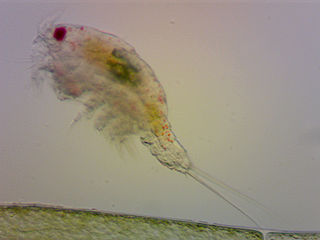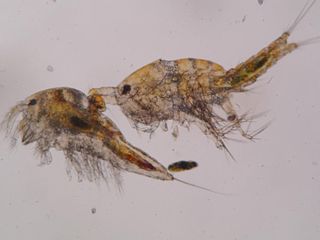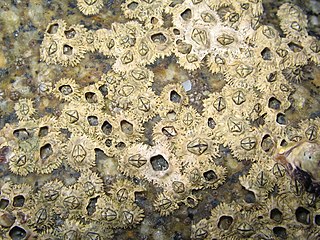Related Research Articles
Tantulocarida is a highly specialised group of parasitic crustaceans that consists of about 33 species, treated as a subclass of the class Hexanauplia. They are typically ectoparasites that infest copepods, isopods, tanaids, amphipods and ostracods.

The Cyclopoida are an order of small crustaceans from the subclass Copepoda. Like many other copepods, members of Cyclopoida are small, planktonic animals living both in the sea and in freshwater habitats. They are capable of rapid movement. Their larval development is metamorphic, and the embryos are carried in paired or single sacs attached to first abdominal somite.

Attheyella is a genus of copepods in the family Canthocamptidae, containing the following species:
Elaphoidella is a genus of freshwater copepods in the family Canthocamptidae. It contains over 200 species, including three classified as vulnerable species by the IUCN – three endemic to Slovenia and one endemic to the United States. In total, the genus Elaphoidella contains the following species:
Leptocaris is a genus of copepods in the family Darcythompsoniidae. One species, the Mexican endemic L. stromatolicolus, is included on the IUCN Red List as a vulnerable species. The genus contains the following species:
Nitocrella is a genus of copepod. Although most other genera in the family Ameiridae are marine, species of Nitocrella are almost exclusively found in subterranean fresh water or brackish water. More than 80 species are included in the genus, including two which are listed as vulnerable species on the IUCN Red List:

Canthocamptidae is a family of copepods. Most of the 700 species are confined to fresh water, although there are also marine species. It contains the following genera:

Ectinosomatidae is a family of the Harpacticoida, a huge group of crustaceans belonging to the subclass Copepoda. Like most of their relatives, they are usually benthic inhabitants of marine environments. Ectinosomatidae commonly inhabit sediment and fragments of dead corals or glass sponges, and occasionally algae and bryozoans, in the deep oceans. In the epifaunal species, the first leg pair is often modified to allow the animals a better grip on the substrate.
Paralubbockia longipedia is a species of copepod, and the only member of the family Paralubbockiidae. The family is characterised by the ventral position of the fifth legs, the possession of a separate maxillary palp, and the form of the endopods of the legs and antennae. The closest relatives of Paralubbockia are the family Oncaeidae. Initially placed among the Poecilostomatoida, Paralubbockia is now considered part of the Cyclopoida.
Robert Gurney was a British zoologist from the Gurney family, most famous for his monographs on British Freshwater Copepoda (1931–1933) and the Larvae of Decapod Crustacea (1942). He was not affiliated with any institution, but worked at home, initially in Norfolk, and later near Oxford. He travelled to North Africa and Bermuda, and received material from other foreign expeditions, including the Terra Nova Expedition (1910–1913) and the Discovery Investigations of the 1920s and 1930s.
Karllangia is a genus of marine copepods. Its name commemorates the Swedish carcinologist Karl Georg Herman Lang. The genus contains five species:

Gelyella is a genus of freshwater copepods which are "surrounded by mystery". They live in groundwater in karstic areas of southern France and western Switzerland. The two species are the only members of the family Gelyellidae and, although previously placed in the order Harpacticoida, a new order, Gelyelloida, was erected for this family alone.
Cletocamptus is a genus of marine and brackish-water copepods, containing the following species:

Tegastidae is a family of copepods, which are characterised by having laterally compressed bodies, a claw-like mandible in the nauplius stage, and by a modified male genital complex. 85 species have been described in 6 genera. Two species of Smacigastes are found at hydrothermal vents, while the remaining species are found in shallow water, associated with algae, bryozoans and cnidarians, such as corals.
Gaussia is a genus of copepods. The genus contains bioluminescent species. It is a "characteristic genus of the mesopelagial", occurring at depths of 0–3,000 metres (0–9,843 ft). The genus Gaussia contains the following species:
Darcythompsoniidae is a family of copepods, containing four genera. Members of the family have a very wide distribution throughout the tropics, where they live in rotting mangrove leaves. They lack egg sacs and are thought to lay their eggs directly into the leaf litter.
Parastenocarididae is a family of copepods in the order Harpacticoida adapted to life in groundwater. It contains the following genera:

Harpacticidae is a family of copepods, containing the following genera:
Mildred Stratton Wilson was an American zoologist, whose work on copepods was awarded a Guggenheim Fellowship in 1955.

The Hexanauplia constitute a class of crustaceans, comprising three groups: the Copepoda, the Tantulocarida and the Thecostraca.
References
- ↑ T. Chad Walter & Rony Huys (2009). T. C. Walter & G. Boxshall (ed.). "Robertgurneya Lang, 1944". World Copepoda database. World Register of Marine Species . Retrieved September 14, 2010.
- 1 2 Rony Huys (2009). "Unresolved cases of type fixation, synonymy and homonymy in harpacticoid copepod nomenclature (Crustacea: Copepoda)" (PDF excerpt). Zootaxa . 2183: 1–99. ISBN 978-1-86977-400-4. Author copy
- ↑ Hans G. Hansson. "Dr. Robert Gurney". Biographical Etymology of Marine Organism Names. Göteborgs Universitet . Retrieved September 14, 2010.